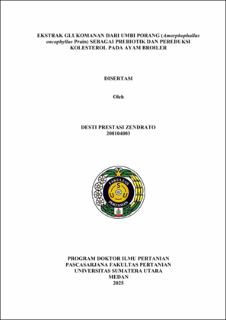Ekstrak Glukomanan dari Umbi Porang (Amorphophallus oncophyllus Prain) Sebagai Prebiotik dan Pereduksi Kolesterol pada Ayam Broiler
Glucomannan Extract from Porang (Amorphophallus oncophyllus Prain) Tubers as Prebiotic and Cholesterol Reducer in Broiler Chickens

Date
2025Author
Zendrato, Desti Prestasi
Advisor(s)
Julianti, Elisa
Tafsin, Ma’ruf
Hanafi, Nevy Diana
Metadata
Show full item recordAbstract
The porang tuber (Amorphophallus oncophyllus Prain) is an indigenous Indonesian tuber plant that is increasingly being cultivated due to its high economic potential. One of the main bioactive components in this tuber is glucomannan, a water-soluble polysaccharide with a high molecular weight, composed of glucose and mannose in a 1:1.6 ratio. Glucomannan is known to have various physiological benefits, including as a dietary fibre, a prebiotic, and a cholesterol-lowering agent. Glucomannan works by promoting the growth of lactic acid bacteria, binding bile acids, and accelerating cholesterol excretion through faeces. These advantages make glucomannan highly promising for development as a natural additive in the animal feed industry, particularly for broiler chickens. Broiler chickens are a type of poultry with rapid growth rates and high feed conversion efficiency, but they produce meat with relatively high fat and cholesterol levels. Additionally, the use of Antibiotic Growth Promoters (AGPs) in broiler feed, which was previously commonly used to enhance performance, has been banned by the Indonesian government since 2018 due to antibiotic residues and the promotion of bacterial resistance. This situation necessitates the development of safe, effective, and environmentally friendly natural feed additives. With increasing public awareness of healthy, low-cholesterol, and synthetic-free animal products, the use of glucomannan as a natural feed additive is a suitable and sustainable strategy for improving broiler meat quality. This study aims to determine the best extraction method for glucomannan from porang tubers based on solvent type and extraction time, test its prebiotic activity and cholesterol-lowering ability in vitro, and evaluate the effects of glucomannan extract supplementation in feed on performance, carcass and meat quality, cholesterol levels, and ND and IBD antibody titers in broiler chickens.
This study was conducted in three phases. Phase I involved evaluating extraction methods using methanol and ethanol solvents at 2, 4, and 6 hours. Parameters observed included glucomannan content, calcium oxalate content, and prebiotic activity through total plate count (TPC) and pH reduction by Lactobacillus acidophilus and Lactobacillus casei. Stage II involved in vitro testing of anticholesterol activity using the Liebermann–Burchard method with extract concentrations of 150-750 µg/mL and measurements using UV-Vis spectrophotometry at 675 nm. Stage III is an in vivo test using one-day-old chicks (DOC) of the Lohman strain (MB 202) without sex separation, totaling 100 birds with an average initial weight of 47.35 ± 3.95 g, divided into four treatments: P0 (Basal Diet), P1 (Basal Diet + 0.2% Glucomannan Extract), P2 (Basal Diet + 0.4% Glucomannan Extract), P3 (Basal Diet + 0.6% Glucomannan Extract) with five replicates per treatment. The parameters observed included performance, carcass and meat quality, meat cholesterol levels, and ND and IBD antibody titers.
The results of Phase I research show that the highest glucomannan content (57.29%) was produced by extracting with an ethanol solvent for six hours, followed by methanol for six hours (50.84%), ethanol for two hours (49.45%), ethanol for four hours (45.71%), methanol for two hours (41.17%), and methanol for four hours (34.48%). The highest prebiotic activity was obtained from the six-hour ethanol treatment, as indicated by Lactobacillus casei, which had a colony count of 1.31 × 10⁹ CFU/mL at a final pH of 4.48, and Lactobacillus acidophilus, which had a colony count of 2.25 × 10⁹ CFU/mL at a final pH of 4.30. This indicates that glucomannan extract can stimulate the growth of probiotic bacteria. Stage II showed that glucomannan extract had significant cholesterol-lowering activity in vitro. The highest reduction, 45.56%, occurred at a concentration of 750 µg/mL. A strong linear relationship was also observed between concentration and cholesterol reduction (R² = 0.9701). Stage III revealed that adding 0.4% glucomannan extract (P2) to the feed resulted in optimal performance in broiler chickens, with an average feed consumption of 459.95 g/bird/week, weight gain of 267.40 g/bird/week, and a feed conversion ratio (FCR) of 1.72. The improved carcass quality is reflected by the high carcass weight (1,024.99 g/bird) and carcass percentage (70.35%) in P2. The abdominal fat percentage in P2 was 0.61%. The meat protein content increased to 23.55% for breast meat and 21.04% for thigh meat, while the meat fat content decreased to 2.01% for breast meat and 3.97% for thigh meat. Cholesterol content decreased in P2 to 68.77 mg/100 g for breast meat and 85.54 mg/100 g for thigh meat. The ND antibody titer in the broiler chickens decreased from 6.00 log₂ (P0) to 4.30 log₂ (P2). The IBD titer fluctuated, reaching its highest value at P1 (5,195.60) before decreasing again at P2 (2,901.00). Despite variations between treatments, antibody titer values remained within the normal physiological range.
Based on the above explanation, it can be concluded that glucomannan extract from porang tubers extracted with ethanol for 6 hours has high prebiotic and anticholesterol activity. The addition of this extract to broiler chicken feed at a level of 0.4% can increase feed intake, body weight gain, feed efficiency, carcass and meat quality, and reduce fat and cholesterol levels. Although there was a slight decrease in antibody titers, the values remained within physiological limits. Therefore, porang tuber glucomannan extract has excellent potential as an effective and safe natural feed additive and can serve as a solution to support the sustainable production of healthy and high-quality broiler chickens.
